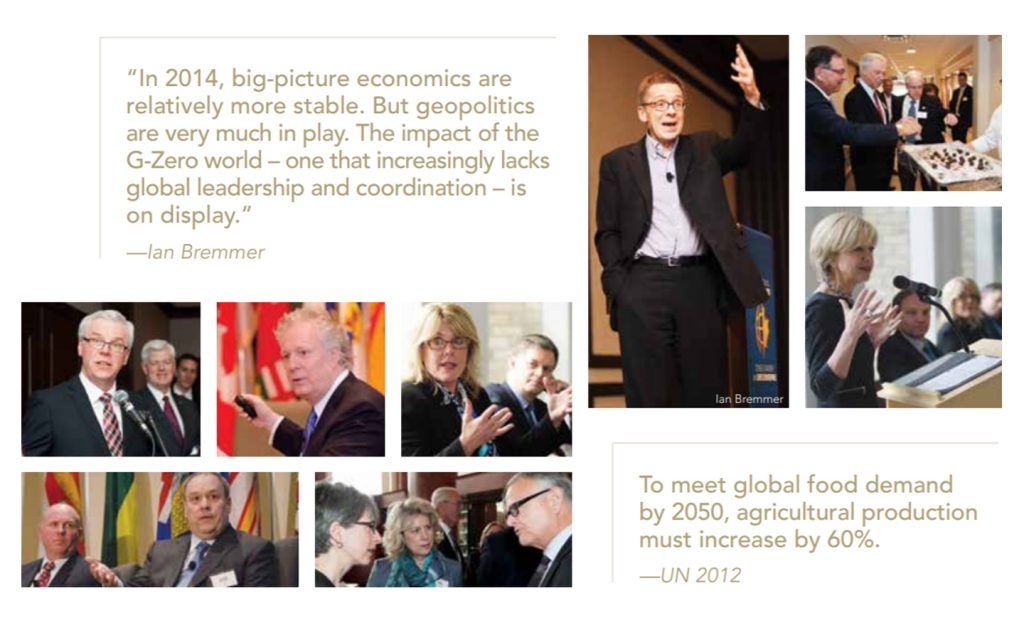Annual Report 2013/2014
Leadership is...
Leadership is…
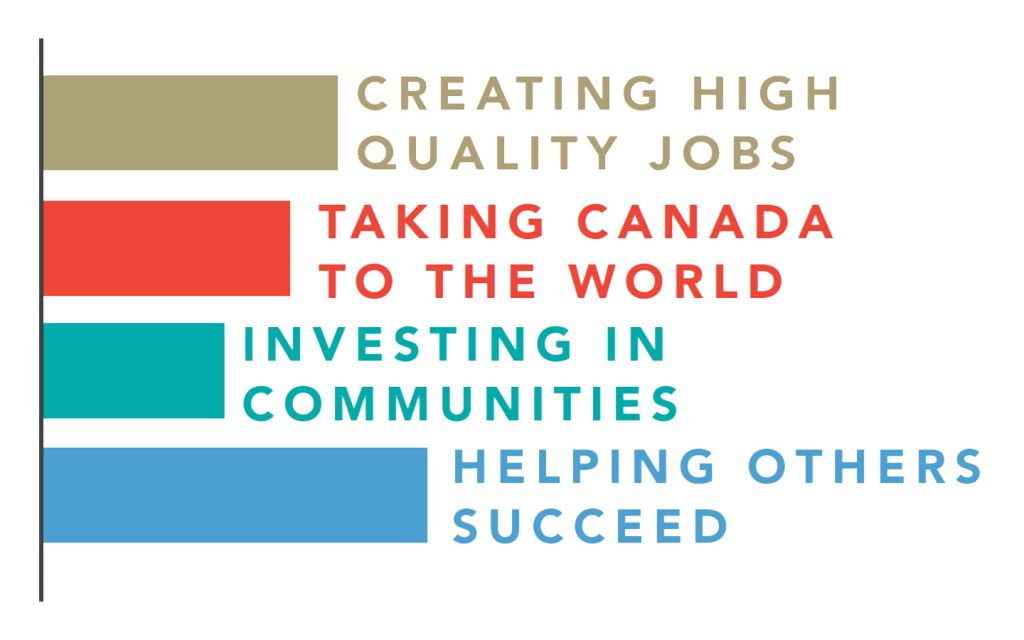
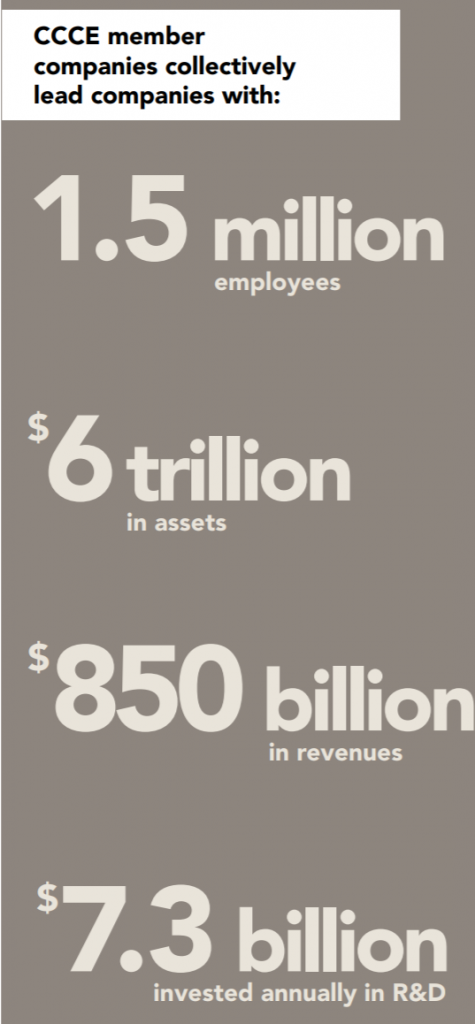
The Canadian Council of Chief Executives brings CEOs together to shape public policy in the interests of a stronger Canada and a better world.

Message from the Chair

At its core, free enterprise is about hope, about providing avenues for people to pursue their dreams of better lives for themselves and their children.” Those words, from a 2002 statement by the Canadian Council of Chief Executives on corporate governance, sum up for many of us our belief in economic freedom as a driver of human progress.
They help to explain why we as entrepreneurs and executives are committed to the long-term health and performance of our enterprises. But just as important as what we do is how we do it. To quote again from that 2002 statement, “Canadians should be able to count on business leaders to instill confidence in the integrity of our financial markets; to add to Canada’s reputation as a country that is well-governed and home to well-run enterprises; and to help Canada in its continuing quest to spread the benefits of democracy and free markets to the less fortunate around the world.”
There was then, and still is now, a debate about the future of corporate governance, and how best to ensure that Canadian business is conducted in the most transparent and ethical manner. One side views corporate governance as a process of compliance with ever more restrictive regulations and procedures. I and my colleagues in the business community, on the other hand, see corporate governance as an expression of values rather than a list of hard and fast rules. While governments have a vital role to play in protecting the integrity of markets, simply adding more rules does not necessarily make markets fairer or better.
Members of the Canadian Council of Chief Executives head companies with a variety of corporate ownership structures, and no single governance framework is appropriate for all circumstances. Nevertheless, there is growing concern within our ranks – and beyond – about the ever-increasing volume of corporate government requirements with which boards of directors must comply. The result is a rigid, “check-the-box” approach that may well prove harmful to the long-term performance of companies. Boards increasingly spend most of their time on the processes and procedures that have come to define so-called “good” governance – leaving little time to cope with critical issues such as long-term strategy, evolving customer needs and the changing competitive environment.
Leadership in business means making decisions and taking calculated risks in a world that is increasingly competitive and unforgiving of missteps. What is needed in any company is a robust governance system that helps to produce sustained performance over the long term to the benefit of all stakeholders.
In short, I believe that the pendulum has swung too far and that we must return to governance basics. This return to basic principles would signal a refocusing on long-term performance and a retreat from the short-termism that afflicts too much of current corporate management.
One example of how far the pendulum has swung is the rise of what are sometimes referred to as “private regulators”. Proxy advisory firms, governance lobby groups and corporate governance rankings have emerged as the unofficial developers and enforcers of governance standards. They often focus on so-called “best practices”, as opposed to value creation.
These third-party influencers have promulgated a long list of corporate do’s and don’ts as they seek to enforce a standardized approach to governance. Some of these organizations are for-profit businesses that operate with little regulatory or fiduciary oversight, and their positions on any given issue could be influenced by any number of factors and potential conflicts of interest. The Canadian Securities Administrators (CSA) have recognized these concerns and recently published for comment a proposed national policy providing guidance for proxy advisory firms. This is a step in the right direction, but more must be done. As the CCCE said in its submission to the CSA: “Our members are concerned that [proxy advisory firm] requirements can too easily become de facto corporate governance standards, without adequate consideration and discussion with affected stakeholders.”
Leadership in business means making decisions and taking calculated risks in a world that is increasingly competitive and unforgiving of missteps. What is needed in any company is a robust governance system that helps to produce sustained performance over the long term to the benefit of all stakeholders. Let us not abandon tried and true practices for a one-size-fits-all mentality imposed by self-appointed “governance experts”. On behalf of Canada’s business leaders, thank you for your interest in our initiatives and policy agenda. CCCE members look forward to working with other decision-makers in all regions and sectors in our mission of building a stronger Canada.
Paul Desmarais, Jr.
Chair

Message from the President and CEO

Over the past couple of years, concern about Canada’s labour market has risen sharply. Some people say we are suffering a “skills crisis”, while others point to regional and industry-specific labour shortages, skill mismatches and, in a few sectors, over-reliance on temporary foreign workers. The issues are real, but in focusing on today’s problems we risk ignoring an even more fundamental challenge. We need to ask whether our country is doing an adequate job of preparing young people – especially those still in school – for the jobs of the future.
Canada invests heavily in education, and historically we have taken pride in the quality of our public education system. Among other achievements, our country is a leader when it comes to ensuring equal access to education for young people from a wide range of socio-economic backgrounds. But past performance, as they say, is no guarantee of future results. And several recent indicators suggest that the quality of Canada’s education system is slipping at a time when education outcomes in many other countries are improving.
Consider the most recent findings of the Program for International Student Assessment (PISA), a triennial study by the Organisation for Economic Cooperation and Development (OECD) that tests the knowledge and skills of 15-year-olds from 65 countries and education systems. To be sure, Canadian students still score well above average in key subject areas. But since the first round of PISA tests in 2000 we have dropped from 9th place to 13th in math, from 2nd to 9th in reading and from 5th to 10th in science.
In some countries, numbers like that would spark a national debate about the quality of the school system and what is needed to improve it. Not so in Canada. For the most part, elected officials who have spoken publicly about the results have tended to shrug them off. At a meeting this past summer, provincial and territorial ministers of education insisted that Canada’s schools are still among the best in the world. As if to prove it, they instructed their officials to look for new ways of measuring student achievement that might cast Canada in a better light.
PISA, however, is not the only sign of weakness in Canadian education and skills development.
To succeed in the 21st century, young Canadians need an education system that is much better than average – it must be among the best in the world.
Another recent OECD study, the Program for the International Assessment of Adult Competencies (PIAAC), found that Canadian post-secondary graduates rank below average in both literacy and numeracy relative to their peers in the developed world. Some suggest that the comparison is unfair because it lumps together university and community college grads. Yet the same study also found that more than a quarter of Canadians with at least a bachelor’s degree – and more than half of all Canadians – fall below what is widely considered the minimum standard of literacy to function in modern society.
In numeracy, Canada’s performance is arguably worse. PIAAC found that Canadians in every adult age group, from 16 to 65, score below the OECD average in their ability to use and interpret basic, everyday mathematical information. As an association that represents the chief executives and controlling shareholders of 150 leading Canadian companies, the Canadian Council of Chief Executives is concerned about the quality of Canada’s education system. Yes, Canada’s schools still do a commendable job overall, and the vast majority of our country’s teachers and educators are dedicated, hard-working professionals. And yes, employers have important roles to play in sponsoring experiential learning opportunities and investing more in workplace training and skill development.
But it is shortsighted to suggest, as many have, that we need not worry about the downward trend in Canadian educational outcomes. As columnist Thomas Friedman of The New York Times observes, the time is past when a person with average skills, doing an average job, could enjoy an average lifestyle. Thanks to globalization, rising competition from emerging markets and rapid advances in information technology, Friedman says, “average is over”. To succeed in the 21st century, young Canadians need an education system that is much better than average – it must be among the best in the world.
The Honourable John P. Manley, P.C., O.C.
President and Chief Executive Officer

Year in Review
Macroeconomic and fiscal policy
After seven straight annual budget deficits, the Government of Canada is once again close to balancing its books. But as the red ink recedes, Ottawa will face significant new challenges. Keeping a lid on public spending is often more difficult in an era of surpluses than when a government is running a deficit. Going forward, the federal government must maintain its commitment to sound fiscal management while gradually reducing the burden of public debt. A low debt-to-GDP ratio provides the best assurance that Canada will have the fiscal capacity to respond next time our country faces an economic downturn.
In its pre-budget advice to the federal government, the CCCE emphasized the need to think carefully before making any new spending commitments. “Among many other benefits, the prospect of budgetary surpluses beginning in 2015–16 creates an opportunity for a broader discussion of the economic and social challenges facing Canada as a whole, and how government can best address those challenges,” John Manley, the Council’s President and Chief Executive Officer, wrote in a January 2014 letter. “We would encourage you to conduct such a review and to identify long-term strategic priorities before making any final policy decisions with respect to the allocation of future surpluses.” In the CCCE’s view, three such strategic priorities are: preparing Canadians for the jobs of the future; designing a corporate tax system that rewards growth; and rebuilding and improving the physical infrastructure – including roads, bridges, ports and energy distribution networks – that underpins our economy.
To promote public understanding of the importance of large enterprises to Canada, the CCCE and PricewaterhouseCoopers collaborated in a comprehensive study of the taxes and fees they pay to all levels of government. The report found that large employers are subject to more than 50 different kinds of taxes and remit, on average, 33.4 per cent of their profits to government. In total, the 63 firms that took part in the study contributed $40.6 billion to Canadian public finances in 2012 while providing employment to 759,276 men and women.
As in previous years, provincial debt levels remain a serious concern, particularly in Ontario. The province’s debt-to-GDP ratio is now nearly 50 per cent higher than before the recent recession, and rising healthcare costs are sure to put added pressure on public finances. In a letter to newly re-elected Premier Kathleen Wynne, the CCCE cautioned that the current fiscal situation is not sustainable and leaves the province vulnerable to another economic downturn. In the words of economist Don Drummond, who chaired the 2012 Commission on the Reform of Ontario’s Public Services, “Decisive, firm and early action is required to get off this slippery, and ultimately destructive, slope.”

Trade and investment
In 2014, Canada will pass an important milestone: exports are expected to catch up with and surpass the levels seen prior to the 2008 recession. Better
still, our country appears poised for an export boom in the years ahead. With one in five Canadian jobs dependant on trade, this is encouraging news for Canadian workers. To maximize the benefits from rising international demand for goods and services, it is essential that our governments and businesses continue to push for access to new and growing markets.
A significant achievement in 2014 was the conclusion of the Canada-EU Comprehensive Economic and Trade Agreement (CETA). When implemented, the agreement will give Canadians preferential access to the world’s largest market. The CCCE supported the government throughout the talks and now sees ratification as a top priority.
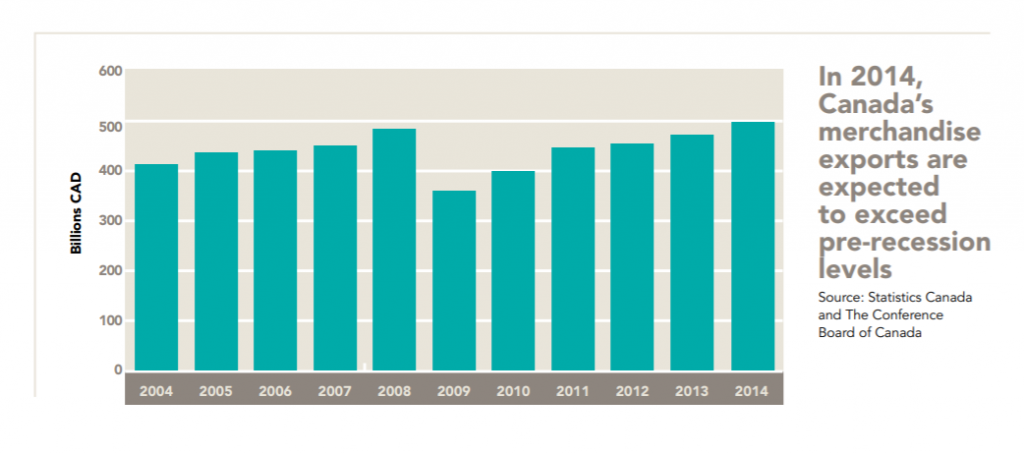
In March 2014, Canada concluded a free trade pact with South Korea after nearly a decade of negotiations. The deal represents a watershed in Canada’s efforts to forge closer economic ties in Asia and will create new opportunities to sell Canadian products in one of the world’s fastest-growing advanced economies. But preferential access to the South Korean market alone does not guarantee success for Canadian companies. Ensuring the agreement lives up to its potential will require resources both to aggressively promote Canadian businesses and to enforce the agreement. The CCCE urged the government to move swiftly toward ratification and pledged its continued support for trade diversification with other Asian partners such as Japan, India and China.
As a member of the federal government’s Advisory Panel for the Global Markets Action Plan, John Manley offered the CCCE’s full support for accelerated efforts in pursuit of Canada’s commercial interests abroad – in particular, the increased use of economic diplomacy. “The Global Markets Action Plan aligns Canada’s trade promotion resources to help Canadian companies take advantage of opportunities in high-growth emerging markets and traditional markets of strength,” he said at the launch of the strategy in November 2013. “By identifying economic diplomacy as a key to advancing Canadian commercial interests, the federal government is ensuring Canadian companies have the support to succeed abroad.”
The CCCE also strongly supports Canada’s participation in the Trans-Pacific Partnership (TPP), a proposed trade agreement among 12 Pacific Rim countries. Based on its current membership, the TPP represents close to $28 trillion in annual economic output – approximately 40 per cent of the world’s GDP. Moreover, the TPP has the potential to expand to include other major economies in the Asia-Pacific region. Concluding an ambitious, high-quality TPP agreement is the most efficient way for Canada to deepen its integration with other Pacific Rim economies and take advantage of Asia’s growing economic performance.
North America
North America’s ability to compete with the rest of the world depends heavily on close cooperation among Canada, the United States and Mexico. The CCCE, in partnership with the U.S.-based Business Roundtable and Mexico’s Consejo Mexicano de Hombres de Negocios, has identified three broad areas where governments should strive to create a more integrated and efficient North American economic space: intelligent border systems, improved regulatory cooperation, and measures to strengthen North American energy security and sustainability. The three CEO-based business organizations intend to continue advocating for progress in these priority areas.
For that vision to become reality, however, political leaders in all three countries need to forge a more constructive relationship. The Canada-U.S. partnership in particular is badly in need of reinvigoration. Priority issues include the U.S. government’s continued failure to approve the Keystone XL pipeline, delays in constructing a new bridge across the Detroit River, protectionist labeling requirements on Canadian beef and persistent “Buy American” procurement provisions. The CCCE has been active in promoting a more far-sighted approach to the relationship, concerned that unnecessary delays in key infrastructure projects and short-term, parochial politics will cost jobs and erode economic potential on both sides of the border.

In December 2013, Ottawa and Washington issued their second annual report card on the so-called Beyond the Border initiative, which is meant to create jobs and boost economic growth by streamlining cross-border commerce. The CCCE welcomed progress in several areas, including in the NEXUS program for frequent travellers between the two countries. However, both sides need to move further and faster to deliver on the vision they outlined in 2011. “Canada’s business leaders urge the Prime Minister and the President to re-emphasize the need for ambitious results,” John Manley said in response to the update. “That should include transforming pilot projects into standard practice and finalizing a Canada-U.S. agreement on pre-inspection and pre-clearance procedures – measures that would significantly contribute to North American competitiveness.”
At the same time, Canada needs to build a more cooperative relationship with Mexico. In 2009, Ottawa imposed a visa requirement on Mexican travellers in a bid to deter bogus refugee claimants. New refugee rules have since dramatically reduced the number of false asylum claims – yet the visa obligation remains in place, creating a significant hurdle for Mexican tourists and business visitors. In February 2014, the CCCE published a major report titled “Canada’s trade with Mexico: Where we’ve been, where we’re going and why it matters”. The report called for the elimination of the visa requirement, expanded border facilitation programs and enhanced cooperation in the energy and mining sectors.
Innovation and competitiveness
For Canadians to compete in a global economy that is increasingly knowledge-driven, firms must constantly innovate. Public policy can play a vital role by encouraging companies to locate high-value jobs in Canada and to increase their investments in research and development (R&D). At the same time, policy makers should refrain from intervening in markets in ways that disadvantage Canadian-based enterprises. In the Council’s view, some of the federal government’s recent policy decisions in the telecommunications sector have failed to respect that principle. “A healthy investment climate requires clarity, fairness and predictability in government policy and regulation,” the CCCE said in a 2013 letter to Prime Minister Stephen Harper. The Council argued that domestic and foreign firms should have equal access to bid on wireless spectrum and equal opportunity to pursue acquisitions of smaller telecom companies. As well, large foreign-headquartered companies that seek to enter the Canadian market should be subject to the same infrastructure build-out requirements that apply to incumbent firms.
In its 2013 Throne Speech, the federal government announced plans to update Canada’s Science, Technology and Innovation strategy. The CCCE response included a recommendation to consider incentives for fast-growing small- and medium-sized companies. When companies grow, they typically spend more on R&D as a share of revenues. Indeed, just 75 large firms account for half of all private-sector R&D in Canada. Concerned that current estimates of private-sector innovation may understate the level of real-world activity, the Council also suggested that Ottawa take a closer look at how innovation is measured. Finally, the CCCE called on the government to implement additional reforms to the Scientific Research and Experimental Development tax credit program with the goal of attracting more R&D investment to Canada.

Later in 2013, the Council launched a multi-year initiative – “Taking Action for Canada: Jobs and Skills for the 21st Century” – aimed at highlighting the importance of a highly educated and skilled labour force. “We need to recognize that Canada is falling behind when it comes to equipping its citizens with the broad knowledge and cross-cutting skills that are required to succeed in an increasingly competitive global economy,” John Manley said in announcing the initiative. As part of its work, the CCCE is publishing a series of papers on education- and skills-related issues and planning to hold a national conference in the spring of 2015.
Cyber attacks pose a different kind of risk to Canada’s economy and competitiveness. In cooperation with the federal government, the CCCE put together a CEO-level advisory panel on cybersecurity to encourage dialogue between the private and public sectors. The Council also published a paper that offers recommendations on how Canadian firms can strengthen their defences against computer- and network-based threats.
Corporate governance
Good corporate governance must be a hallmark of Canadian business. High standards of corporate behaviour and responsiveness to the concerns of shareholders and the broader community not only influence the ability of firms to grow and prosper in Canada, but are essential to the Canadian “brand” and how Canadian companies are perceived in international markets.
Canadian companies continue to improve their standards of transparency and accountability. They are doing so at a time of increasing scrutiny by activist investors, proxy advisory firms and a wide range of advocacy groups. Collectively, these players can impose significant and sometimes competing demands on companies and their boards of directors.
When companies grow, they typically spend more on R&D as a share of revenues. Indeed, just 75 large firms account for half of all private-sector R&D in Canada.
The CCCE believes that governance frameworks should not unduly restrict the ability of boards to respond to changing business circumstances, and that excessive rule-making should not hamper the ability of Canadian corporations to pursue long-term, sustainable growth. Companies should be encouraged to recruit directors on the strength of their business acumen, sector experience and ability to advise on matters of short- and long-term business strategy, rather than on the basis of their expertise in the more technical aspects of today’s governance rules.
A recent and welcome development is the announcement of an initiative spearheaded jointly by the Canada Pension Plan Investment Board and the international consulting firm McKinsey & Company, titled “Focusing Capital on the Long Term”. Their goal is to re-orient institutional investors and their portfolio companies towards long-term value creation initiatives and away from what they call “the pervasiveness of short-termism” and an obsessive focus on quarterly results. The CCCE fully supports this initiative and plans to work closely with its proponents.
Energy and environment
Canada’s abundant energy resources are important drivers of economic growth and job creation. They generate billions of dollars in government revenues, supporting the social programs and other public services that improve the lives of all Canadians. Canada’s energy and resource industries are also leaders in the development of new technologies, products and services that are helping to meet domestic and international needs in an environmentally sustainable fashion.
The CCCE strongly supports the work of the premiers and territorial leaders in their efforts to craft a responsible, coherent and pan-Canadian energy strategy that will create economic wealth for Canadians in all regions. Our belief is that, by working together, Canadians can position their country as a global leader in energy technology and as a secure, reliable and responsible supplier of energy to the world.

A key priority is to ensure that Canadian producers have the ability to get energy resources to tidewater. At the same time, our country must continue to work toward a close energy partnership with the United States and Mexico. Policies aimed at strengthening the continent’s oil, natural gas and electricity transmission systems will enhance energy security and improve economic prospects for citizens in all three countries, while simultaneously boosting the competitiveness of North American industry.
Over the past year, CCCE representatives held a series of meetings with government officials, business organizations and key policy experts in both Washington, DC, and Mexico City. The ultimate goal of these efforts is to increase North American energy self-sufficiency through streamlined regulatory approval processes, improved cross-border energy infrastructure, and enhanced cooperation in the development of new energy and environmental technology.
At the North American Leaders’ Summit in February 2014, Prime Minister Stephen Harper, President Barack Obama and President Enrique Peña Nieto gave priority to the continental energy agenda and directed their energy ministers to develop a detailed work plan in the year ahead. CCCE will work with like-minded organizations in all three countries in support of measures that will boost North America’s energy advantage.

From Acorns to Mighty Oaks
Canada needs to turn more small businesses into global powerhouses.
As the saying goes, mighty oaks from little acorns grow. In much the same way, almost every great business can trace its origins to humble beginnings, whether in a garage, a workshop, a strip mall or a home kitchen. And just as giant trees are essential to the eco-system that nurtures young saplings, so large businesses help create the conditions for small enterprises to grow and prosper. Indeed, no economy can reach its full potential without healthy, large businesses.
The jobs they create, the taxes they pay, the training they provide, the innovation they spawn – and much more – are the ingredients for success in an increasingly open and competitive global marketplace.
Canada needs many more business powerhouses – companies like our country’s leading banks and life insurers, aerospace manufacturers, energy and mining firms, transportation and telecommunications providers, and so on.
Countries of a similar size – such as Spain, Italy, South Korea, Brazil and Mexico – nurture their corporate champions and take pride in them. Canada needs to do the same. Here’s why…
Leadership is… Creating High Quality Jobs

Industry Canada defines a large company as one that employs at least 500 people. By that measure, only 0.2% of all firms in Canada are large. That’s one large company for every 330 small and medium-sized firms. Yet that tiny slice of Canada’s business community created more than 46% of all new private-sector jobs between 2001 and 2011.
Large companies were the leading job creators in seven of those 10 years. By contrast, most small businesses created no new net jobs during that period – many actually shed jobs or went out of business.
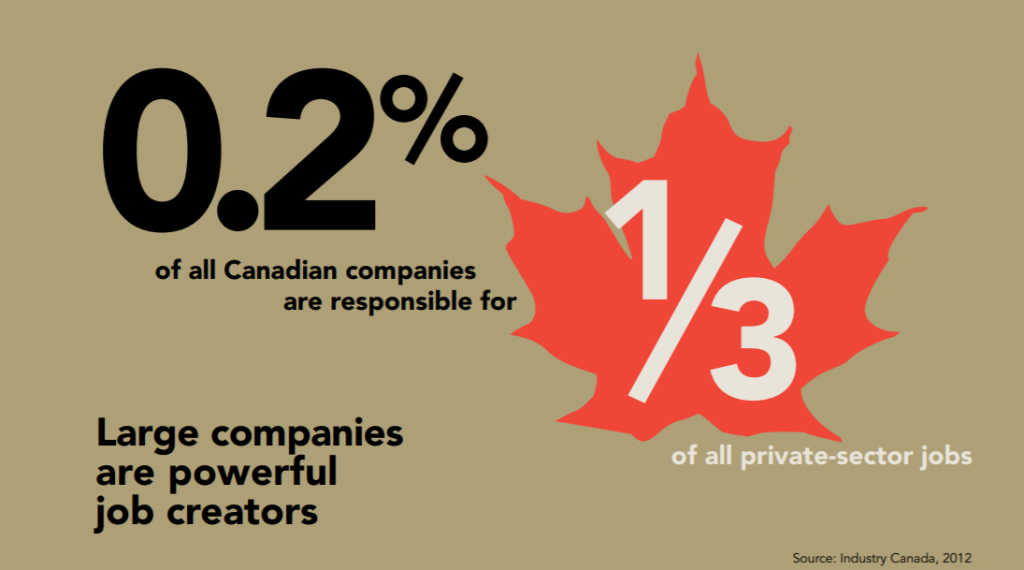

Employees of large companies earn higher wages
Workers at large companies earned an average of $941/week in 2011, compared to $832 at mid-sized firms and $763 at small businesses. Employees at large companies also typically receive more generous benefits. Insurance and pension coverage at large firms is roughly four times higher than at small businesses. And workers at large companies generally enjoy higher vacation pay, more sick leave, and more bereavement leave.


Employees receive more training at big firms
As workers in China, India, Brazil and elsewhere become more educated, pressure is growing on Canadians to upgrade their skills. At companies with more than 500 employees, more than half the workforce takes part in job-related training or education, compared to 44% at mid-sized firms and 37% at small enterprises. Furthermore, nearly seven out of 10 workers at large enterprises who enroll in education programs receive support from their employer, compared to 39% of those at small businesses.
Leadership is… Taking Canada to the World

Large businesses are the most active exporters
The bigger a business, the more likely it is to export – earning valuable foreign currency, creating jobs and promoting Canada on the world stage. The vast majority of small companies stick close to home: only 1.3% of small businesses were exporters in 2010. By contrast, 43% of large enterprises sold their goods and services abroad. As small firms grow, they gain the resources needed to broaden their horizons: legal and linguistic support,
access to export financing, greater management depth, international networks, and so on. They can also stay the course for longer – often an
essential condition for breaking into new markets.
Large companies spend more on innovation.
Innovation is critical to rising productivity and sustained economic growth. And when it comes to innovation, size matters. Enterprises with 500 or more employees make up more than half of all industrial R&D spending. By contrast, small companies – which make up over 98% of the number of businesses – contribute less than one-third of industrial R&D outlays.
The OECD reported in 2012 that just 25 companies in Canada account for one-third of all business R&D.


Productivity is higher at big firms
A 2013 Statistics Canada study found that large firms are more than twice as productive as small companies, based on output per hour of work. Bigger enterprises typically invest more in capital per employee. They have longer – and thus more efficient – production runs. They employ more highly skilled workers. The gap is widest in capital-intensive industries where large businesses are most active, such as mining, oil and gas, utilities, manufacturing and transport.
Leadership is… Investing in Communities
Large businesses tend to donate more to charitable causes
Large companies have the scale and resources to contribute generously to non-profit organizations and charities. According to the Canada Revenue Agency, 80% of all charitable donations and gifts from the business community in 2006 came from large companies. Large businesses are also far more likely to conduct fund-raising campaigns among their employees, to match employee donations, and to give workers paid time off for volunteer activities.
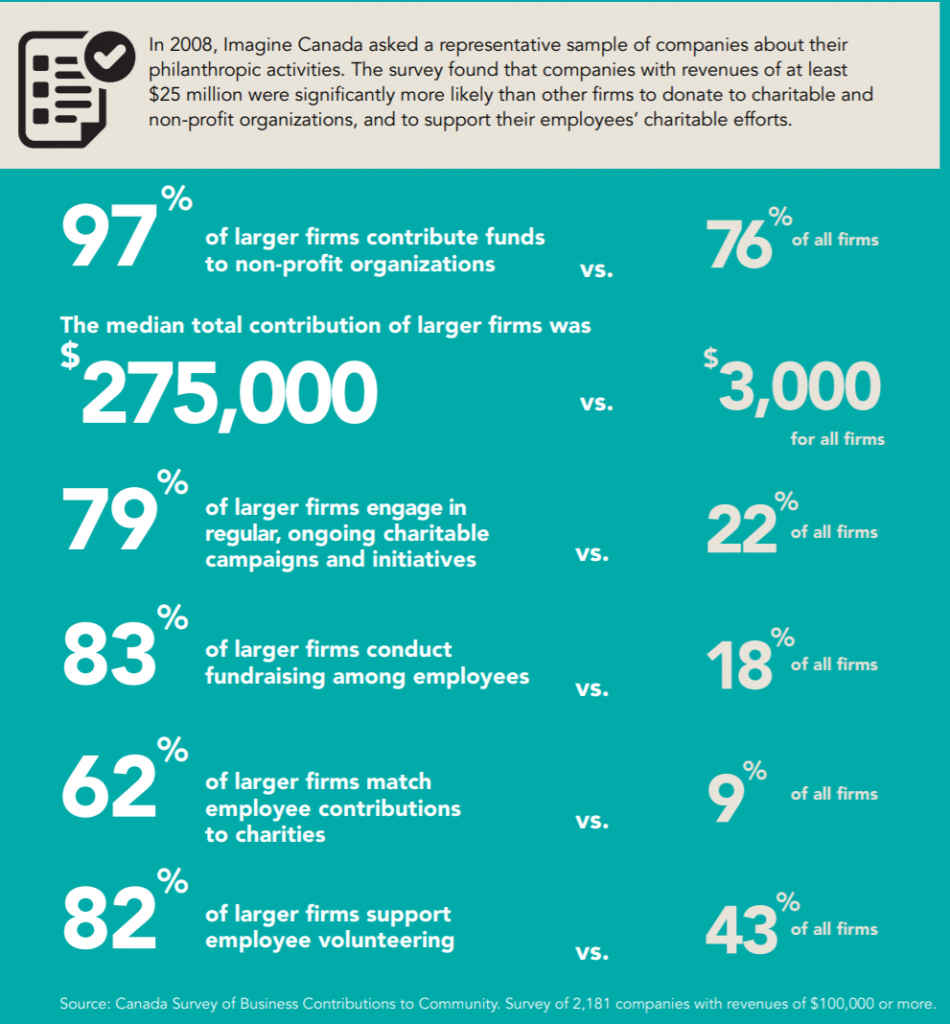
Bigger firms pay the lion’s share of taxes
Corporate tax revenues have grown since 2000, despite the 2008–09 recession and a significant drop in corporate tax rates. Large companies – those with more than $15 million in assets – make up 6.6% of all business tax filers. Yet they pay almost 73% of corporate income taxes. One reason is that large corporations pay substantially higher tax rates than small enterprises. Income tax is by no means the only contribution by businesses to the public coffers. A recent PwC survey of 63 large companies concluded that for every $1 of corporate income tax paid, they contributed another 94 cents in other business taxes, and 59 cents in various other levies.

Leadership is… Helping Others Succeed
Large companies are important supporters of small business
Who looks after the potted plants in a big company’s offices? Who supplies sandwiches for lunch-hour meetings? Who cleans the offices at night? Who gets the call for specialized training courses? Who provides business cards?
As often as not, these jobs go to outside contractors, many of them small enterprises.
The US Centre for an Urban Future estimates that seven out of ten businesses grew in both revenue and size within two years of joining a large company’s supplier network. The most successful small enterprises eventually become large companies themselves, making a growing contribution to the economy and creating opportunities for the next generations of start-ups. In business as in nature, we need mighty oaks as well as small acorns if that cycle is to keep repeating itself.

CEO Summits
The full membership of the Canadian Council of Chief Executives meets three times a year in cities across the country, and occasionally beyond our borders. These events provide chief executives of Canada’s leading enterprises with unparalleled opportunities to exchange views with their private-sector peers as well as senior domestic and international policymakers.
Over the past year, CCCE meetings took place in New York City, Toronto and Winnipeg. Former President Bill Clinton opened the New York meeting and shared his perspectives on current U.S. and international policy challenges. After a tour of the 9/11 Memorial Museum construction site, members gathered at Brookfield Place for an address by Governor Andrew M. Cuomo of the State of New York. Other speakers and participants included Jeffrey R. Immelt, Chairman and CEO of GE; and James Dimon, Chairman, CEO and President of JPMorgan Chase & Co.; William Ackman, Founder and CEO of Pershing Square Capital Management LP; J. Tomilson Hill, Vice Chairman of The Blackstone Group; and Wilbur L. Ross, Jr., CEO and Chairman of WL Ross & Co. LLC.
In Toronto, CCCE members toured the waterfront headquarters of Corus Entertainment and discussed the impact of social media with the Canadian heads of Google, Facebook and Twitter. Later, renowned management expert Clayton Christensen spoke about his most recent work on disruptive innovation. During a morning-long session at MaRS Discovery District, David Rosenberg of Gluskin Sheff & Associates shared his latest economic forecast, after which members engaged in a CEO roundtable on current business conditions. Later, an expert panel explored the challenges facing Canada’s early-stage companies.
The future of Canada’s agri-food sector was the dominant theme of the Winnipeg meeting, which opened with a tour of the Paterson GlobalFoods Institute and included sessions on food trends and the impact of technology on Canadianfarming. Other agenda highlights included presentations by The Honourable James Moore, Minister of Industry; The Honourable Greg Selinger, Premier of Manitoba; The Honourable Jean Charest, former Premier of Quebec; and Ian Bremmer, one of the world’s leading experts on geopolitical risks.
New York
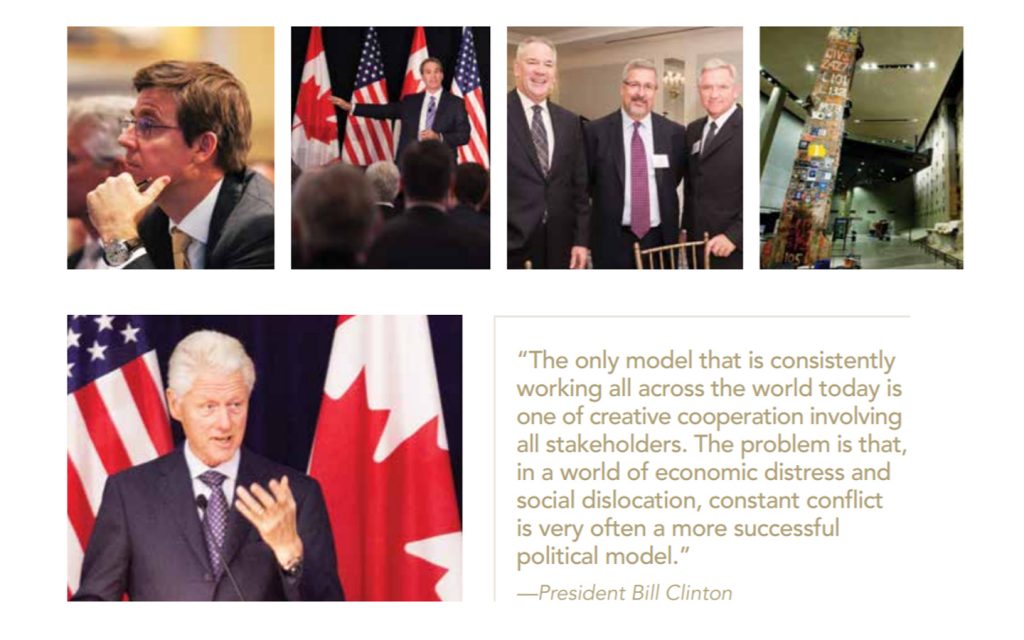
“The real opportunity for change is still ahead of us, surpassing the magnitude of the development and adoption of the consumer internet. It is what we call the ‘Industrial Internet’, an open, global network that connects people, data and machines. The Industrial Internet is aimed at advancing the critical industries that power, move and treat the world.”
Jeffrey R. Immelt, Chairman and CEO of GE
Toronto
MaRS Discovery District
Toronto’s MaRS Discovery District supports entrepreneurs in the sectors of ICE (IT, communications and entertainment), cleantech and physical sciences, and life sciences and healthcare by providing them with advice, education and market research, and connecting them to talent, customers and capital.

Corus Quay
Corus Quay incorporates a number of energy efficient LEED Gold features, such as four green roofs, gray water recycling, advanced building and lighting automation, a fivestorey-high bio-filter wall and is predicted to use 64% less water and 33% less energy. The interior includes a three-storey human slide, open-concept work area, no floor to ceiling walls, a games area, a screening room and a gallery space featuring rotating exhibits of art created by employees.
Winnipeg
